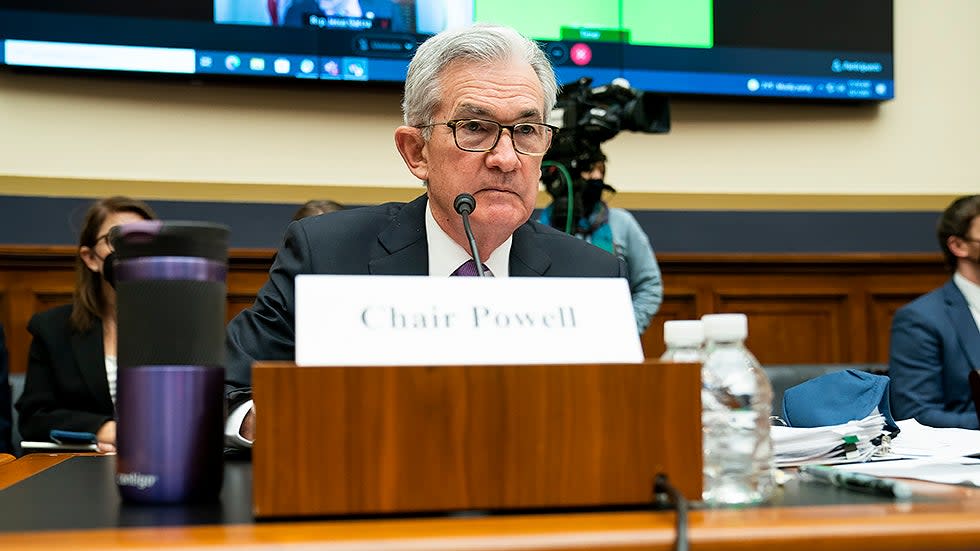Fed to speed up taper, projects three rate hikes in 2022

The Federal Reserve on Wednesday announced a faster timeline for pulling back the stimulus it has deployed to support the economy through the coronavirus pandemic as inflation surges.
The Federal Open Market Committee (FOMC), the Fed's monetary policy arm, said it would taper its monthly purchases of Treasury bonds and mortgage-backed securities at a quicker rate than it laid out in November.
Fed officials also projected three interest rate hikes in 2022, accelerating their expected timeline for raising borrowing costs.
The Fed had been purchasing at least $80 billion in Treasury bonds and $40 billion in mortgage-backed securities each month since March 2020 to keep borrowing costs low and credit markets flowing.
The bank said last month it would reduce Treasury bond purchases by $10 billion each month and mortgage bond purchases by $5 billion each month with prices climbing and the labor market strengthening.
Under the new timeline laid out Wednesday, the Fed will reduce Treasury bond purchases by $20 billion each month and mortgage bond purchases by $10 billion each month. The Fed will still purchase at least $40 billion in Treasury bonds and $20 billion in mortgage bonds per month, but said it would likely adjust the pace deeper into the year.
The Fed was widely expected to speed up its taper following the FOMC's two-day meeting this week as inflation steamed well above levels the bank expected earlier in the year.
Inflation as measured by the Commerce Department's personal consumption expenditures index without food and energy prices - the Fed's preferred gauge of price growth - rose 0.4 percent in October and 4.1 percent annually. The index on the whole rose 0.6 percent in October and 5 percent annually.
The Fed aims to keep the annual core inflation rate at an average 2 percent each year. The bank did not step in to cool off inflation earlier by raising interest rates or pulling back on stimulus, which would have also likely slowed the recovery from the pandemic.
Even so, Fed Chairman Jerome Powell and most Fed officials have said the job market is strong enough and inflation has run high enough to begin pulling back on the stimulus that stoked a strong recovery. Powell said the current pace of the taper would end asset purchases by March.
"With elevated inflation pressures in a rapidly strengthening labor market, the economy no longer needs increasing amounts of policy support," Powell said in remarks following the announcement.
"In addition, a quicker conclusion of our asset purchases will better position policy to address the full range of plausible economic outcomes."
The Fed kept its baseline interest rate range between zero and 0.25 percent, the level set amid the onset of the pandemic in March 2020. While the Fed has not announced when it will hike interest rates, FOMC members expect the bank to begin raising borrowing costs sooner than they did in September, according to projections released Wednesday.
Ten of the 18 members of the FOMC projected that the Fed would hike rates three times in 2022, bringing the baseline interest rate range to 0.75 to 1 percent. Five members expected two hikes, two members projected four hikes and one member expected just one rate hike in 2022.
Only three FOMC members projected at least two rate hikes next year in the Fed's September estimates.
Fed officials also significantly increased their projections for inflation in this year and next while lowering their projections for unemployment and economic growth.
The FOMC's median estimate of the year-end inflation rate as measured by the personal consumption expenditures (PCE) index rose from 4.2 percent in September to 5.3 percent on Wednesday. Fed officials projected the PCE index with out food and energy prices, known as "core" inflation, to hit 4.4 percent by the end of the year, up from 3.7 percent in September.
The FOMC's median estimate of year-end unemployment fell to 4.3 percent from 4.8 percent in September. The median estimate of the 2022 unemployment rate also dropped from 3.8 percent in September to 3.5 percent this month.
Updated at 2:47 p.m.

